The resumption of the UEFA Women’s Champions League will be a welcome sight to many after the early finishes to the domestic leagues. Arsenal and Paris Saint-Germain will be contesting in the other tie of the night but the game we’re looking at more closely here is Olympique Lyon Feminin vs Bayern Munich. While Lyon will be favourites to win the tie, Bayern Munich are not a side to just roll over as they will pose a significant threat to the serial French winners.
This tactical analysis will analyse both systems of play and how each team can pose a significant threat to the other. Through the analysis of previous games, we will look to understand how Bayern Munich and Lyon will set up in order to secure a place in the semi-finals.
Bayern Munich’s build-up structure
Starting off with Bayern Munich’s approach in possession, we will understand their build-up and attacking style to see how they are likely to penetrate through Lyon’s world-class midfield and cause them defensive issues.
Bayern’s starting shape and formation rotates between the 4-4-2 (29%) and 4-2-3-1 (23%). The close percentages suggest that both systems are interchangeable within the game and is something the team is comfortable doing. If we look at Bayern Munich across the season they’ve been very successful in controlling possession coming out from the back and this is where it begins. Their goalkeeper looks to find one of the two central defenders who then want to find a full-back, specifically the left-back to progress the ball. One central midfielder drops closer towards the centre-backs to offer an outlet and cover in case of a turnover in the wide areas. This is also used as an alternative method of progression.
The full-backs look to get high wide as they look to stretch teams. If the wide defenders are pressed or have no real way through, they recycle possession back centrally where the centre-backs will now look to go central and find a central midfielder or the deep-lying forward higher up.
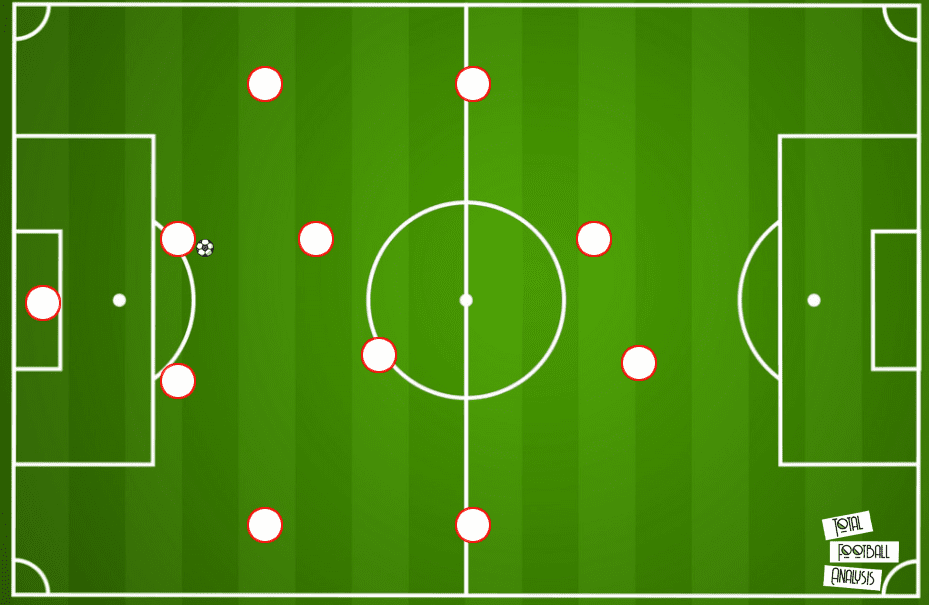
Part of what makes Bayern such a dynamic side in build-up is the ability of their central midfield pairings to play complementary roles. Both players are adept in possession and have good spatial awareness to create space and take advantage of any space in midfield. Pushing the full-backs higher means there is an emphasis on the central midfield duo to help cover the spaces in behind and provide support in the event the opposition manage to win the ball back in the final or middle third.
Firstly, with the full-backs playing high, we often see teams play a lop-sided formation where one full-back is more dominant than the other and the case remains the same here. The full-backs will generally stand in line with the #6 and look to push on from there. Bayern’s left-side is much more attacking which is why they prefer to attack through here. The athleticism and intelligence on the ball of the left-back makes her a key outlet and one which teams have tried to solve this by looking to close down spaces. Though to negate this issue, having a double-pivot can help increase the superiority in midfield with one midfielder always looking to support the wide players and create overloads in these areas. Lyon are known to have a dynamic and all-action midfield setup that uses positional rotations to good effect, which will make this duel very interesting.
Bayern have also been seen to build-up through the central areas. When the wide areas are closed off or there isn’t a clear path to progress the ball down the flanks, Bayern will look to use their ball-playing centre-backs to push up and play progressive passes to their forwards. One of the main advantages of progressing through the central areas is the full-backs are able to push up more aggressively and pin the opposition back. Even if the opposition look to press centre-backs, Bayern can take advantage of the spaces in midfield. However, with the opposition expecting Bayern to go wide, they tend to push their wide players up, opening up space behind the full-backs to exploit. The graphic below depicts this and allows Bayern Munich to manipulate the wide spaces in midfield whilst allowing their team to still take advantage of building up through their full-backs.
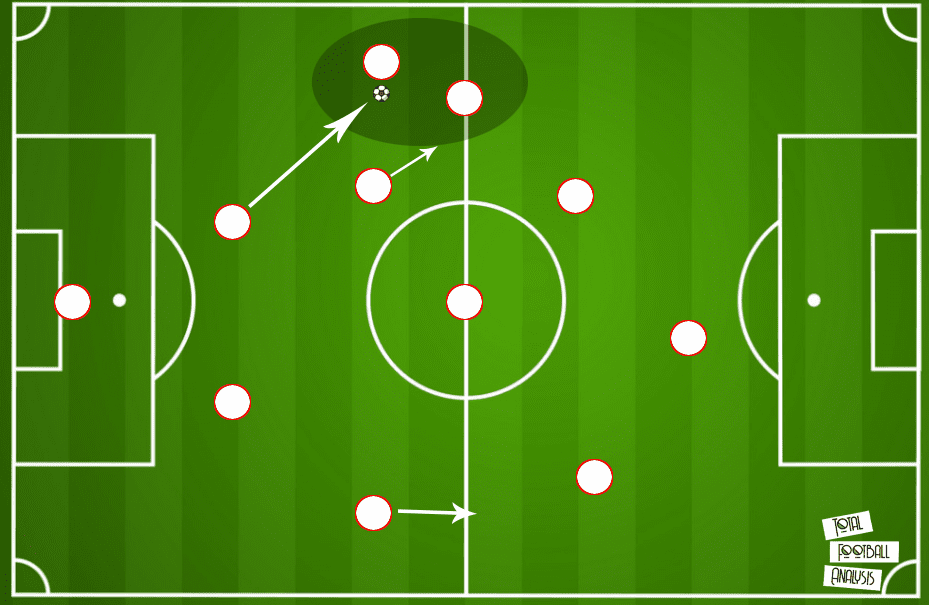
Alternatively, they will also pass it directly into the final third where the attack-minded central midfielder or deep-lying forward will come to receive possession. Both of Bayern Munich central midfielders have to be proficient in possession to ensure the ball remains in Bayern’s hands and initiates the interchangeable play in the final third. Through these methods, Bayern have shown a competent way of progressing play through the thirds, but what do they do when they reach the final third?
Bayern Munich attacking wide vs. Lyon’s defensive structure and press
Naturally, with Bayern looking to build-up through the wide areas, width will be their main outlet of attack. The team will look to shift forward together and ensure that they have numerical superiority in the wide areas to keep possession and create space by forcing defenders to move towards the ball side. This looks to open up enough space between the central defenders for a player to make a run through and allow the centre-forward to compete in a 1 vs 1 battle. Bayern are excellent in the wide spaces and making use of the pace and intelligence their wide players have is essential to their development. Guilia Gwinn and Carolin Simon’s partnership is what makes Bayern tick. Their movement and understanding is what allows the German team to operate effectively and their interchange allows them to get in behind opposition defenders.
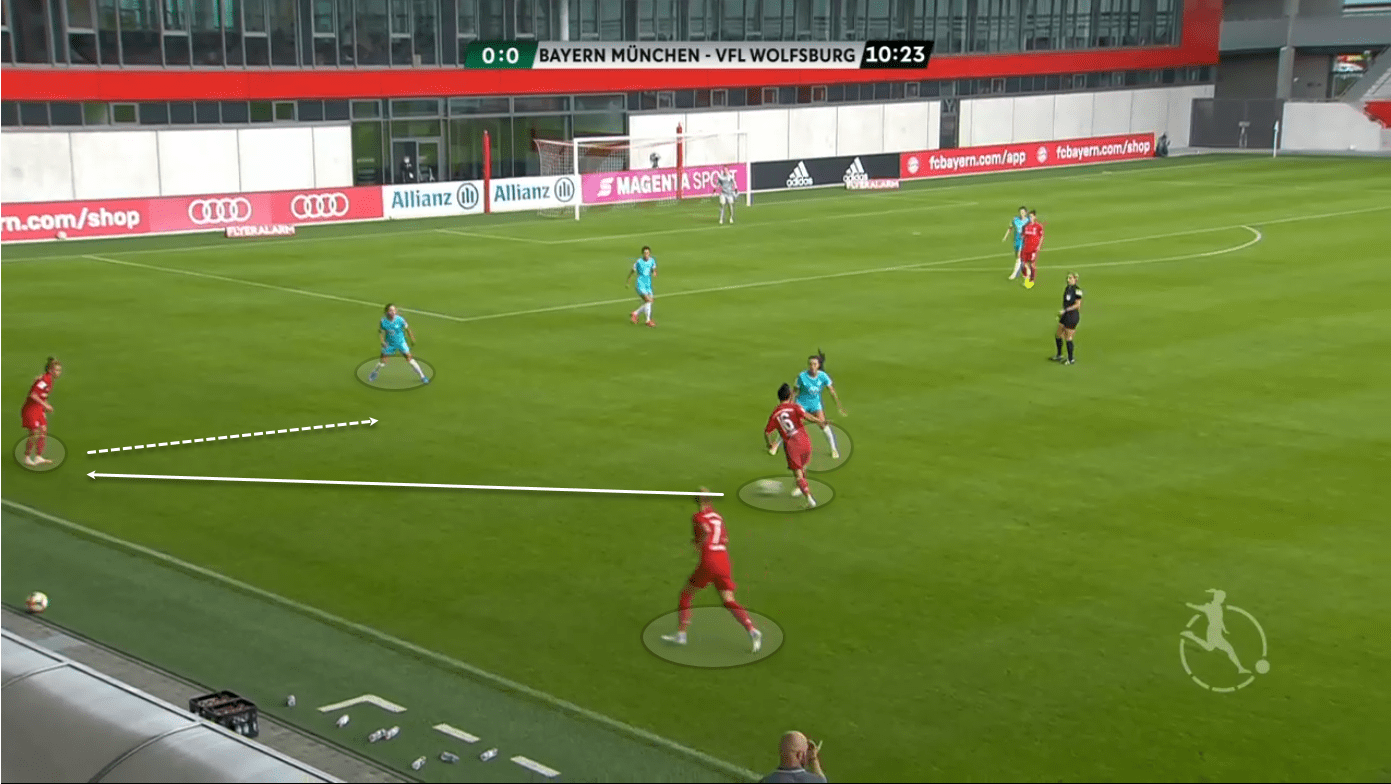
We can see an example of this against Wolfsburg where Lena Magull is looking to pass out towards Linda Dallmann who is positioned wide on the left. Gwinn’s presence alone keeps Wolfsburg wary of Bayern’s movement as they look to force the Wolfsburg midfielder to move across and cover the wide space.
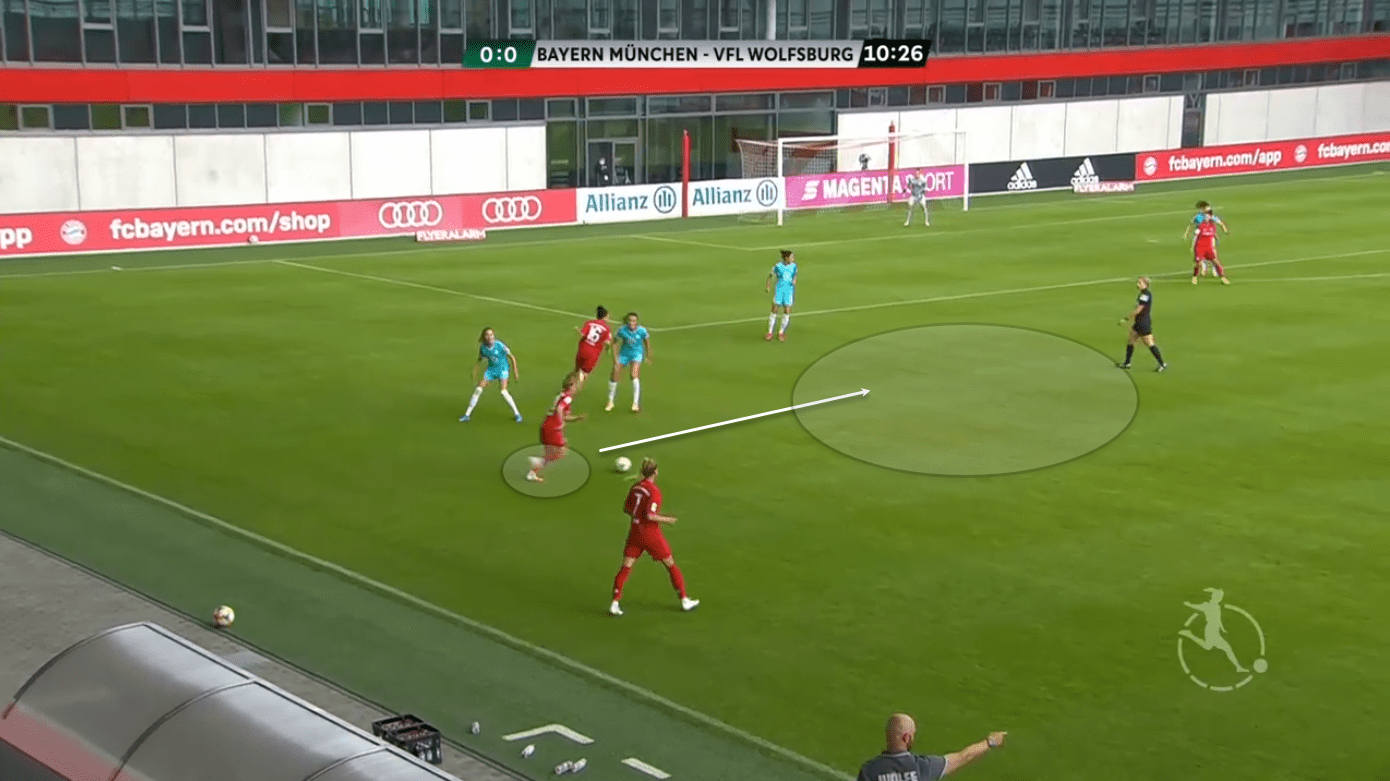
As Dallmann drives across the box, we can see Magull run through the two markers with Jovana Damnjanović occupying the lone centre-back. There is now space between the centre-backs and just in front of the box for Dallmann to run into and shoot or pass. The graphic below depicts their crossing nature and we can see the majority of their crosses come from the left-hand side. The two highest crosses have been Simon (27) and Gwinn (21) which supports our notion of their partnership being key to Bayern’s attacking success.
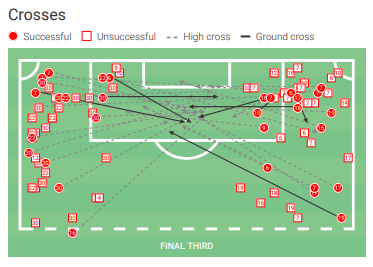
So how do Lyon stop Bayern Munich from exploiting them in the wide areas?
Lyon will adapt their 4-2-3-1 into a 4-4-2 and maintain horizontal compactness. They ensure they have their central spaces covered first and foremost with one full-back tucking inside whilst the other tracks back into position. Their main prerogative is to win back possession as soon as possible and this is usually done in a counter-pressing manner especially if the turnover occurs in the middle of the pitch. They want to win the ball back high which is where Amandine Henry and Saki Kumagai come to the fore. Their defensive line plays high which often means that they’ll win defensive headers or step up to make tackles.
Structurally, the wingers will come back to assist but their full-backs are often apt in 1 vs 1 duels and in Lucy Bronze have arguably the best full-back in world football. While the two full-backs will adjust according to the situation, the right-back will tuck in to make it three at the back whilst the left-back will push forward and support any pressing movements with the central midfielders. Lyon most often have most of the possession which means they play with a high defensive line. While there is potential space in behind, it also means Lyon look to win turnovers in midfield. As a result, Bayern Munich will need to use their wingers effectively to run through the channels and in behind their defensive line. Gwinn and Dallmann will be critical to this especially because both Lyon centre-backs are not the quickest. This will place even more emphasis on the full-backs and defensive midfielders to cut off the half-spaces.
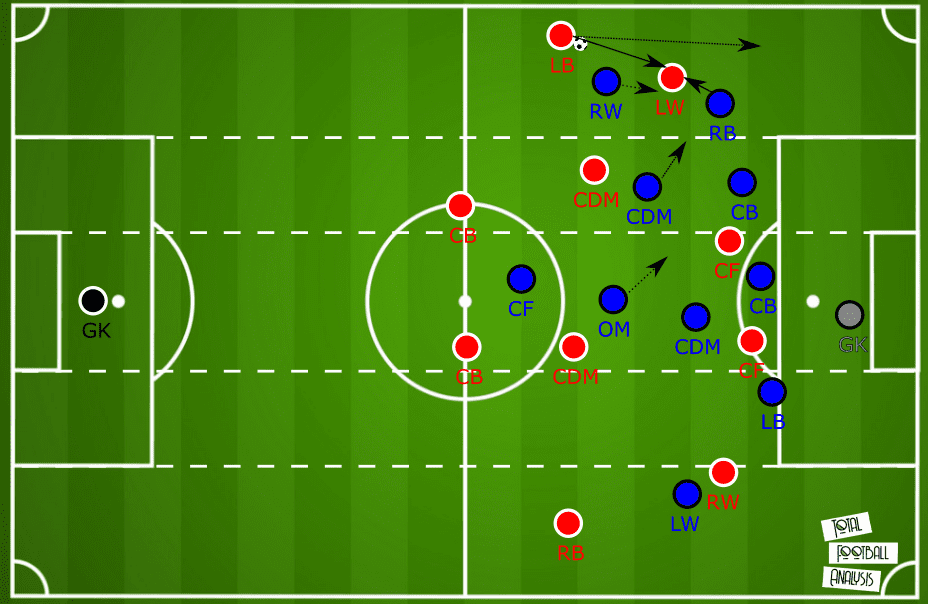
The graphic above gives us a theoretical understanding of Lyon’s setup out of possession and how they are likely to try and stop Bayern Munich from pushing down the flanks. In this case, the emphasis will be on Gwinn and Simon to overload Bronze. Assuming Bayern play to the strengths of their two best wide players, they will want to bring Griedge Mbock across to help defend against the overload thus opening up space for Dallmann to glide through. Though, this is where Lyon’s midfield comes into play. When the full-back pushes up in support of the midfielders to press the opposition ball carrier, the remaining Lyon midfielder will look to plug the gap behind the press to block off any potential passing lanes and provide cover between the lines. Between Kumagai and Henry, the closest player will push up towards the ball carrier alongside the full-back and winger to create the pressing situation. The other player will move in to cover while Dzenifier Marozsan will drop into central midfield to fill in the space vacated by the aforementioned midfielder.
Not to mention that if Bayern look to play centrally, Kumagai will slot in between the centre-backs to allow a player to step out and press aggressively whilst having enough bodies in the box. These constant positional rotations give Lyon their ability to close spaces and always have a player over.
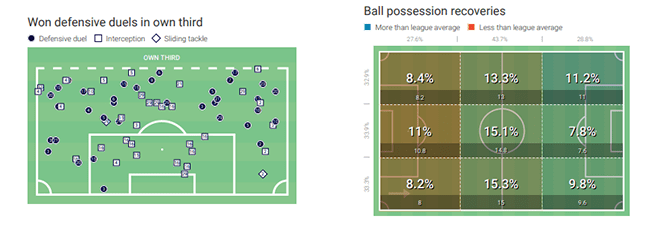
Taking a look at both these graphs, we can see that Lyon win most of their balls in midfield (43.7%) with 15.1% and 15.3% coming from the midfield and right-midfield areas. This is likely to continue against Bayern especially with their strength coming from the left.
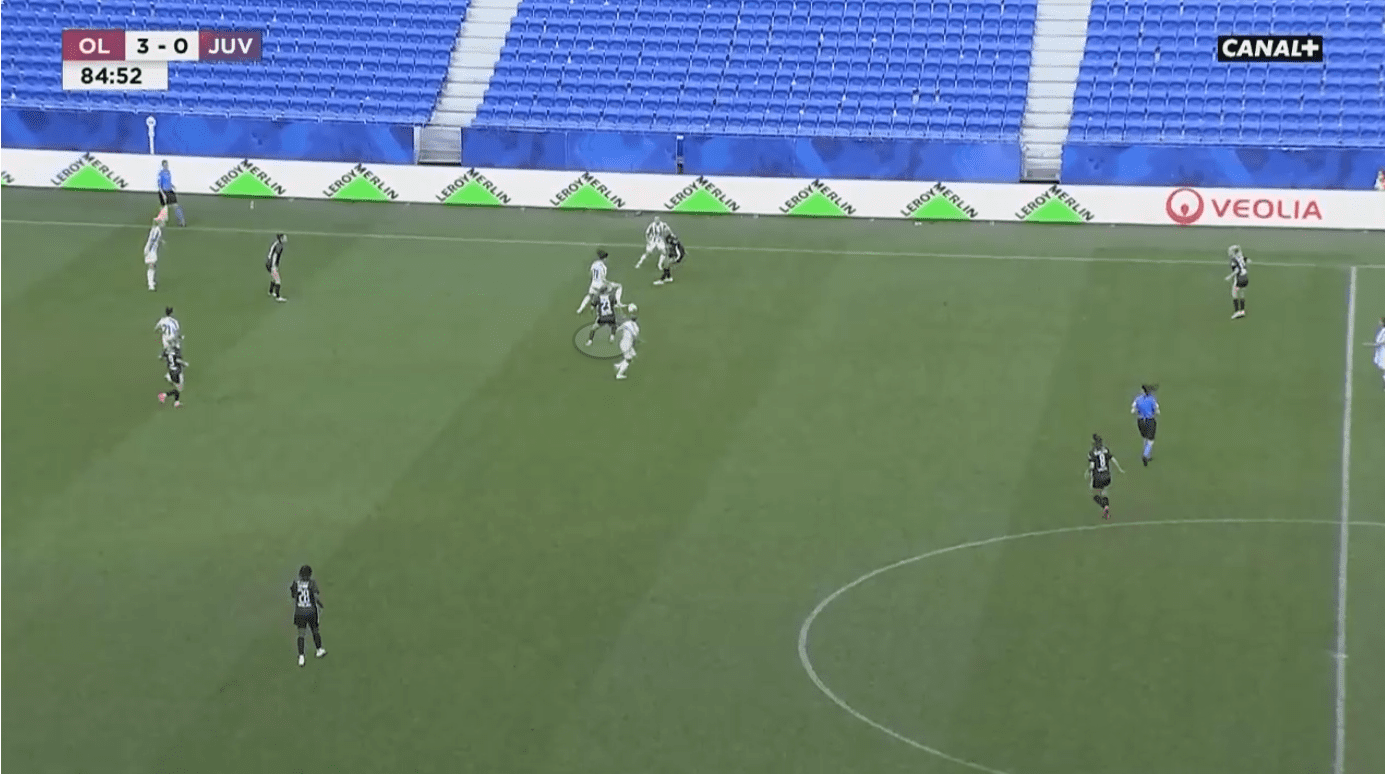
This example shows a Lyon midfielder looking to win back possession in an intense pressing manner after losing the ball. The Juventus ball carrier is turning as she receives the ball, but the quickness of Lyon’s pressing doesn’t leave her enough time to properly control possession.
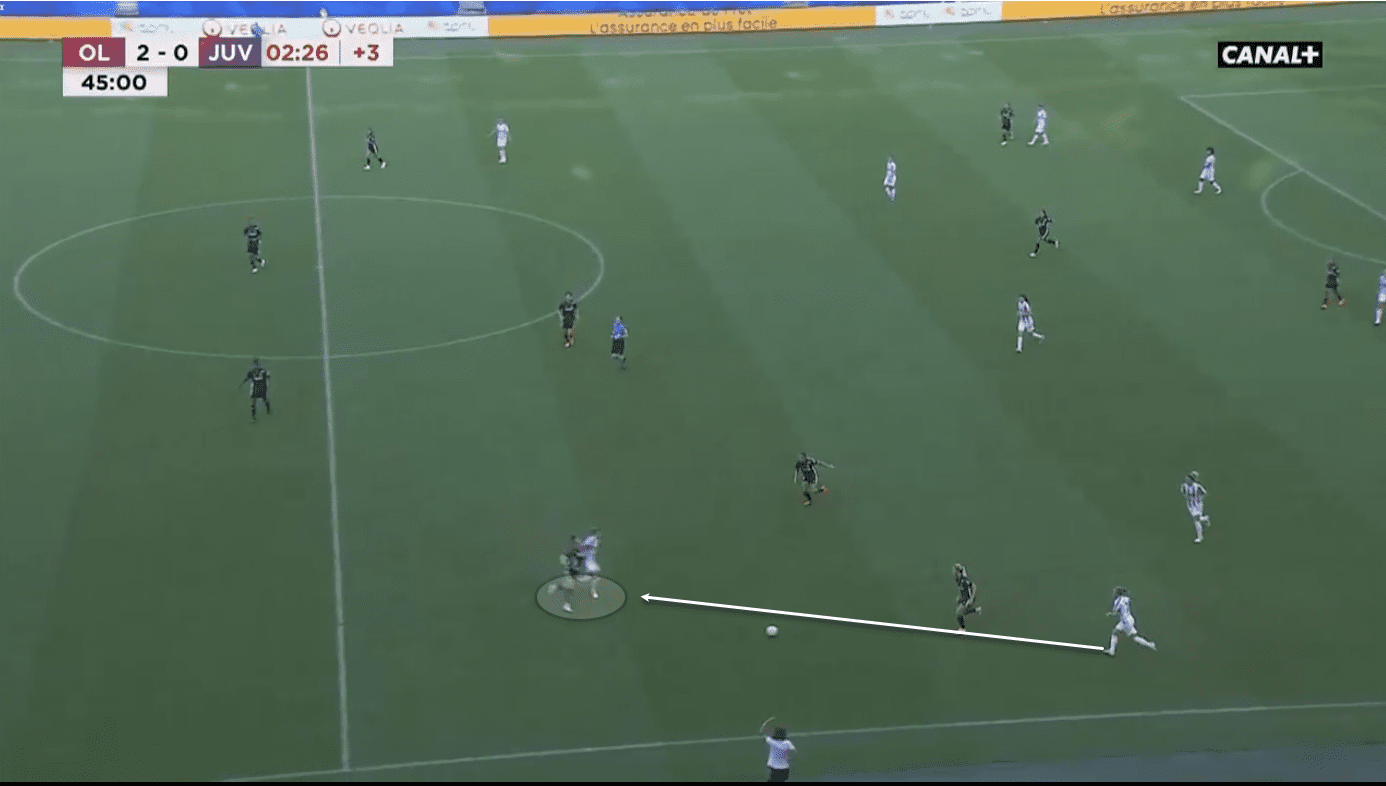
Additionally, we can see Bronze stepping up to press the ball receiver with Henry, and Delphine Cascarino coming into support the press. As I alluded to earlier, possession in the wide areas triggers a pressing sequence with the central midfielder and near-sided winger coming into press.
Olympique Lyon’s build-up vs Bayern Munich’s press
In this section, we’ll detail Lyon’s build-up and how their midfield will be used to their attacking advantage despite missing talismanic forward Ada Hegerberg. I will also explain how Bayern’s press could work to put Lyon under pressure.
Before we expand on Lyon’s structure and build-up, let’s detail Bayern’s pressing ideologies and what they might look to do.
Bayern’s pressing structure isn’t as aggressive and reactive as Lyon’s, however, their basic system is predicated on getting numbers behind the ball and applying more pressure the deeper they are. Similar in the way a pressing mechanism triggers in the wide areas for Lyon, Bayern Munich are similar in that their wide pairing becomes essential when it comes to stopping their opposition counterparts from attacking down the flanks. Going up against Lyon’s 4-2-3-1, their 4-4-2 should, in theory, be a good counter especially because of Lyon’s preference to progress through the flanks. With a mixture of Bayern inviting pressure into their own half and Lyon using their wingers and full-backs to create crossing situations, the battle for possession and turnover will be most prevalent here.
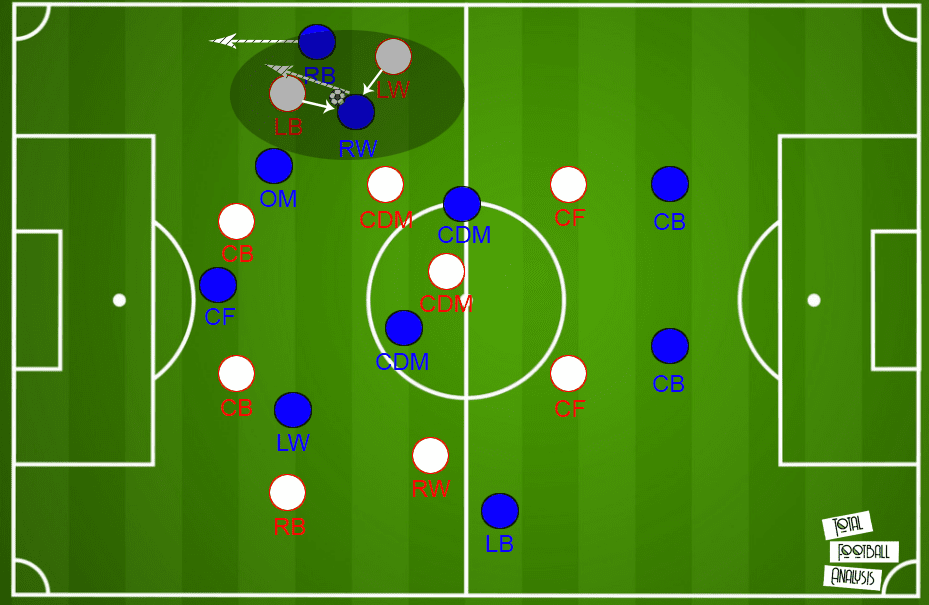
Against Wolfsburg, we saw Bayern used a mid-block to stop their midfielders from getting the ball into their attackers. They used their two centre-forwards to press their centre-backs who were the first line of progression forcing them to spray the ball out wide. In doing so, they ensured Wolfsburg played the ball into an area where they felt most comfortable and could possibly look to do the same to Lyon. Both centre-backs aren’t the quickest, especially Renard. Though Renard is good on the ball, she doesn’t have the most abstract range of passing, so this could be a potential target for Bayern.
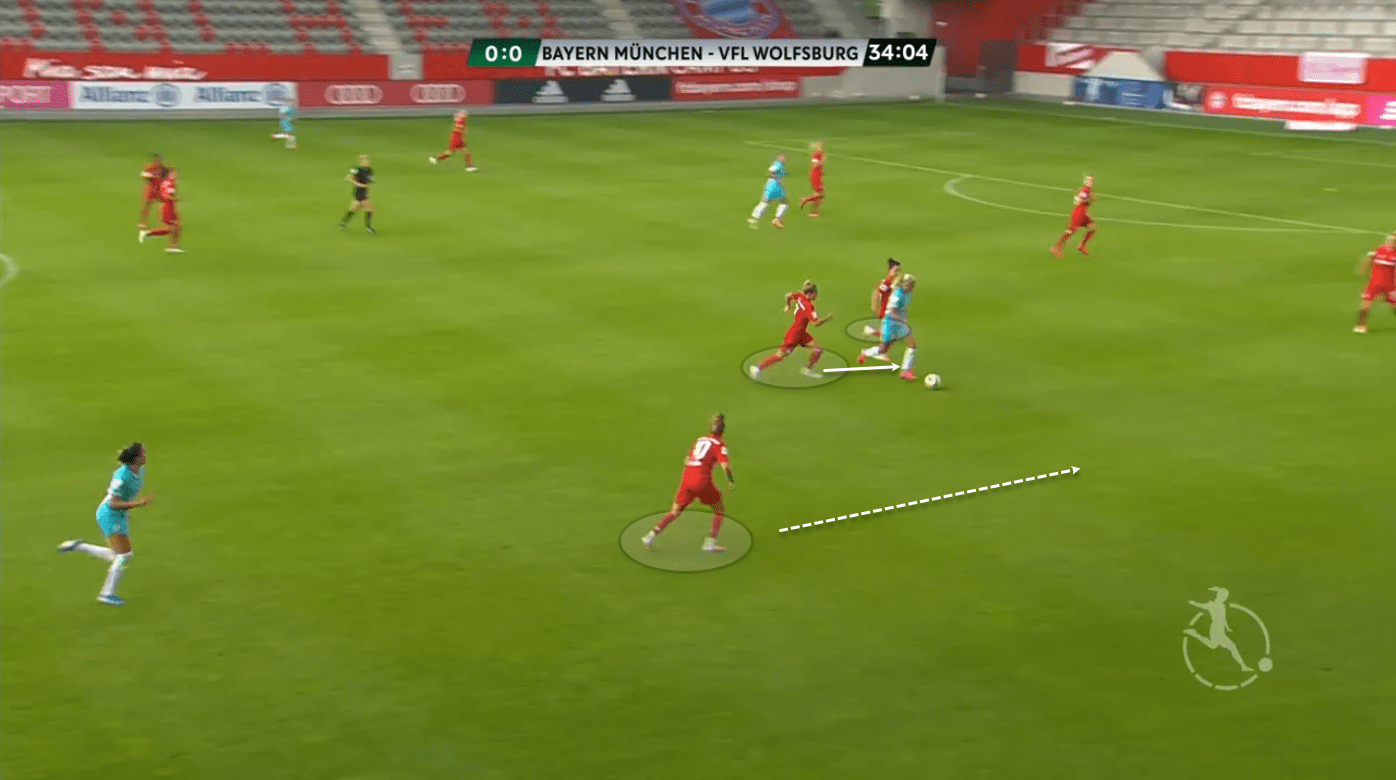
Here against Wolfsburg, we can see Magull and Gwinn closing down and forcing Pernille Harder to go wide after receiving the ball in midfield. What should also be noted is Bayern have their back four in line along with Dallmann (#10), Melanie Leupolz, and Lineth Beerensteyn (centre) all dropping deep.
How Olympique Lyon overload Bayern Munich’s press
Lyon’s shape starts off in a 4-2-3-1 but they rarely stick to the formation strictly as the team’s core fundamental tactic revolves around positional rotations. Both in defence and attack, rotations play an integral part to the team’s build-up and attacking phases of play. Bayern will line up in their 4-4-2 which will look to remain compact out of possession and could see the wide players tuck in to ensure they have numbers to match Lyon’s three-man midfield.
The centre-backs split wide allowing the full-backs to push up giving them a high base to start with. The main objective is to constant ball movement and rotations without allowing the ball to be static for longer than two touches. Both Kumagai and Henry are the main progressive initiators in midfield while Marozsan creates goal scoring opportunities in the final third. The centre-backs initial pass is to get the ball to the full-backs after which the ball moves centrally to bring the two defensive midfielders into play.
Kumagai and Henry have different roles with Kumagai playing a more defensive cover and support role by often dropping in between the two centre-backs when Lyon have possession in their own half. Henry is the instigator and roaming creator. Her job is to act as a supporting figure in terms of a passing option and ensure possession is moving forwards by linking play. Marozsan is the team’s main attacking link player and will ensure they keep possession well in the final third and provide an attacking threat with her key passes. The German might look slow but her movement is intelligent and perfectly timed. She finds space and has the ability to release passes quickly, even in the smallest of spaces.
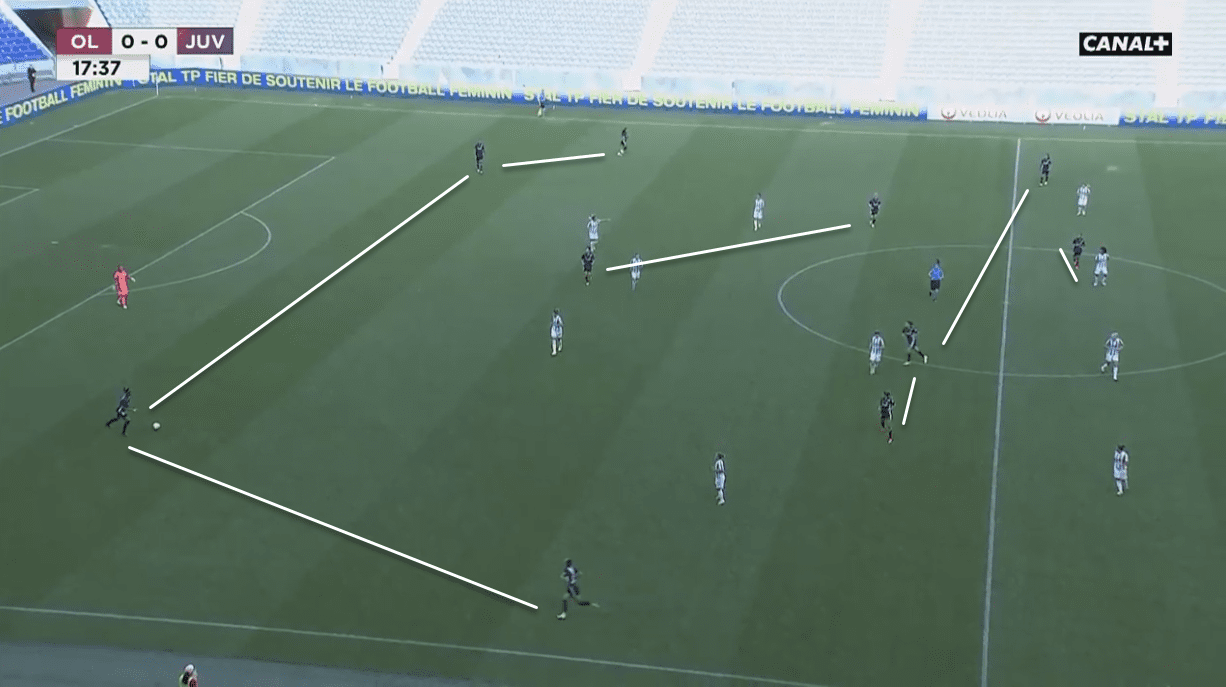
The image above shows Lyon in their typical shape when the ball is played out from the back. This is where they try to make the pitch as wide as possible with both full-backs high and Kumagai in a position to fill in at centre-back. Marozsan can be seen dropping into a deeper position to assist in build-up, and ensure Lyon are not outnumbered by Juventus’ numbers. This is another example of the positional rotations Lyon constantly use in their matches.
Now, when it comes to getting the ball into the danger areas, Lyon will use a number of passing interchanges and rotations as I’ve alluded to earlier. Lyon are patient in build-up and will not force the initiative if the opportunity isn’t there. Instead, they will pass and probe with quick one-two touch passes combined with their rotations to force the opposition to press and possibly create enough space between the lines of midfield and defence. Adding in a mobile Nikita Parris only helps bring more support but will leave Lyon without a recognised focal point.
A key aspect for Lyon to avoid and overload Bayern’s off the ball tactics will be their two central midfielders. Both Henry and Kumagai’s movement and creativity will be key in bypassing the press and shifting the opposition players around. In the example below we can see a patient Lyon start to switch the ball from right to left after playing a series of passes on the far side.
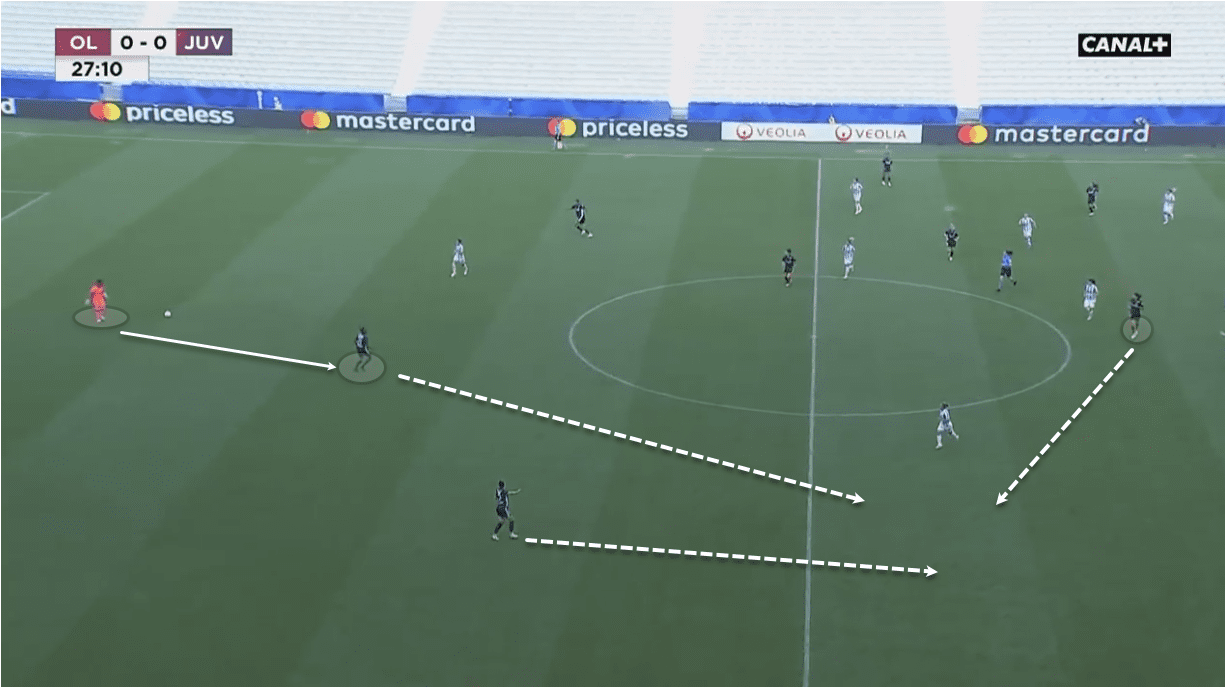
Below, we can see the ball is played in between the lines with Marozsan the ball receiver to bypass Juventus’ midfielders. However, what Kadeisha Buchanan’s direct pass into Marozsan also does is divert Juve’s attention towards her. The aim here is to have Bronze, Delphine Cascarino, and Marozsan involved to bypass Juventus’ compact backline.
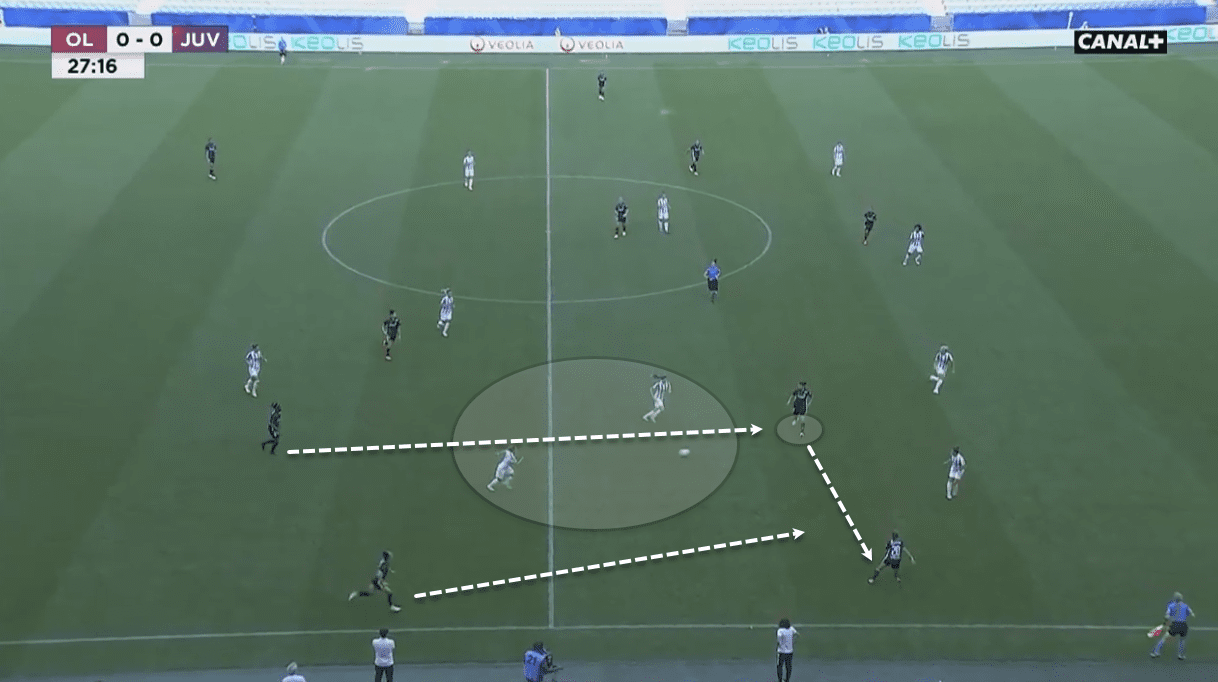
Lastly, we can see the pass from Marozsan into Cascarino allows Bronze to make a quick run in behind the Juve full-back. I believe it’ll be impossible to stop every Lyon passing combination but Bayern’s high tempo pressing can stop Lyon. Marozsan’s added run creates an overload in this area forcing the Juventus full-back to come across. This allows Parris a 1 vs 1 with the centre-back, who she should beat for pure speed. With no focal point for Lyon in the absence of Hegerberg, Parris will play a much more fluid and mobile role which could suit Bayern because it would allow them to reinforce their backline and defend against crosses better, however, Lyon are excellent at making up the numbers in the box.
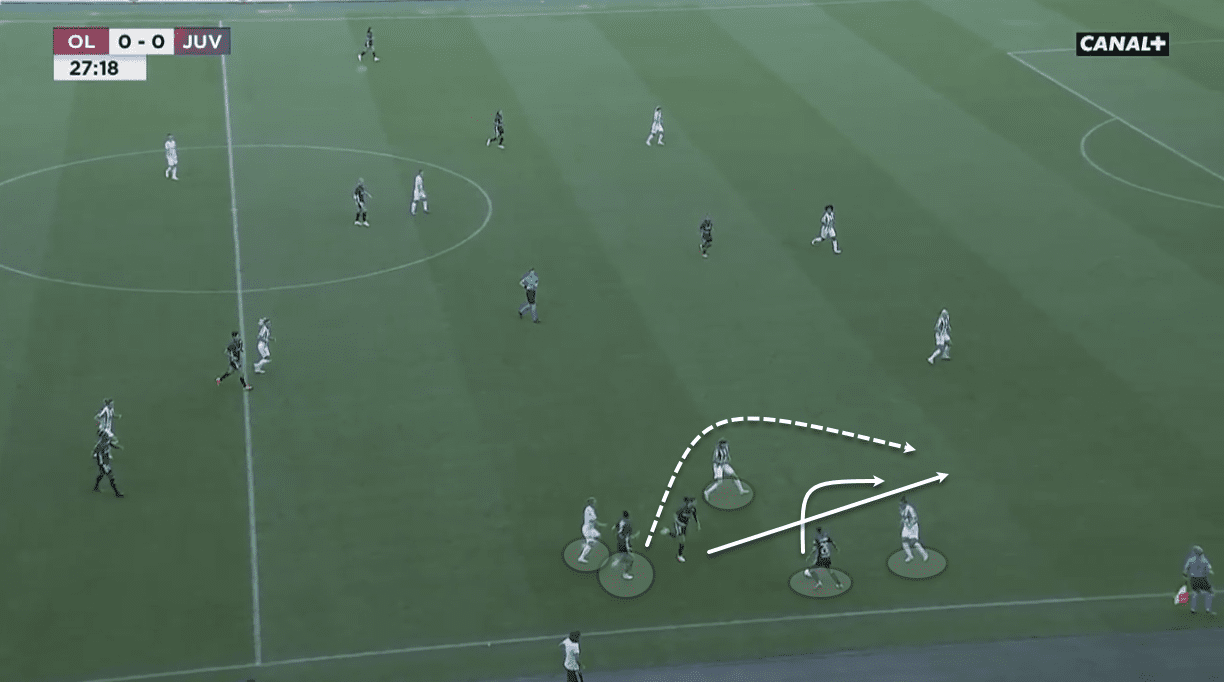
Predicted line-ups
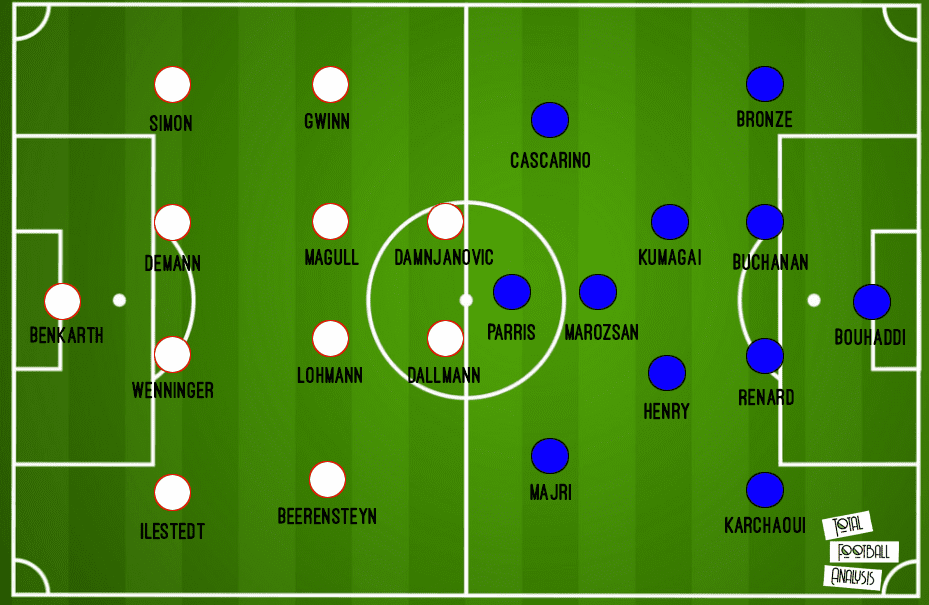
As far as the line-ups go, Jean-Luc Vasseur has pretty much settled on his first choice 11, with a couple of choices in some positions. The absence of Hegerberg has seen Parris establish herself as the team’s number 9. The midfield trio is pretty much nailed on to be Kumagai, Henry, and Marozsan with Sara Gunnarsdottir not eligible to play in this season’s competition after featuring for Wolfsburg earlier in the campaign. Mbock’s injury means Buchanan will partner Renard alongside Bronze. The only two spots that are up for contention are left-back and right-wing. I suspect Karchaoui to start over Bacha with Cascarino preferred over Shanice van de Sanden at right-wing.
Bayern Munich have lost the services of Leupolz after her move to Chelsea but otherwise, I expect to field their strongest 11 in their favoured 4-4-2. Sydney Lohmann is considered a rising German star and is the likely long term replacement for Leupolz and should start alongside Magull.
Final remarks & Predictions
I would expect Lyon to have just enough to beat Bayern Munich, however, I believe they will face a side that will give something to think about. Teams have been finding ways to beat this unstoppable force but have failed to do so but the German club could have enough to post a threat.
I think the first half will be slightly cagey with both teams feeling each other out with the goals coming in the second half. Lyon will miss Hegerberg but I think they have just enough in them with a scoreline of 3-1. The longer the game goes, the more space Lyon will have to play through.



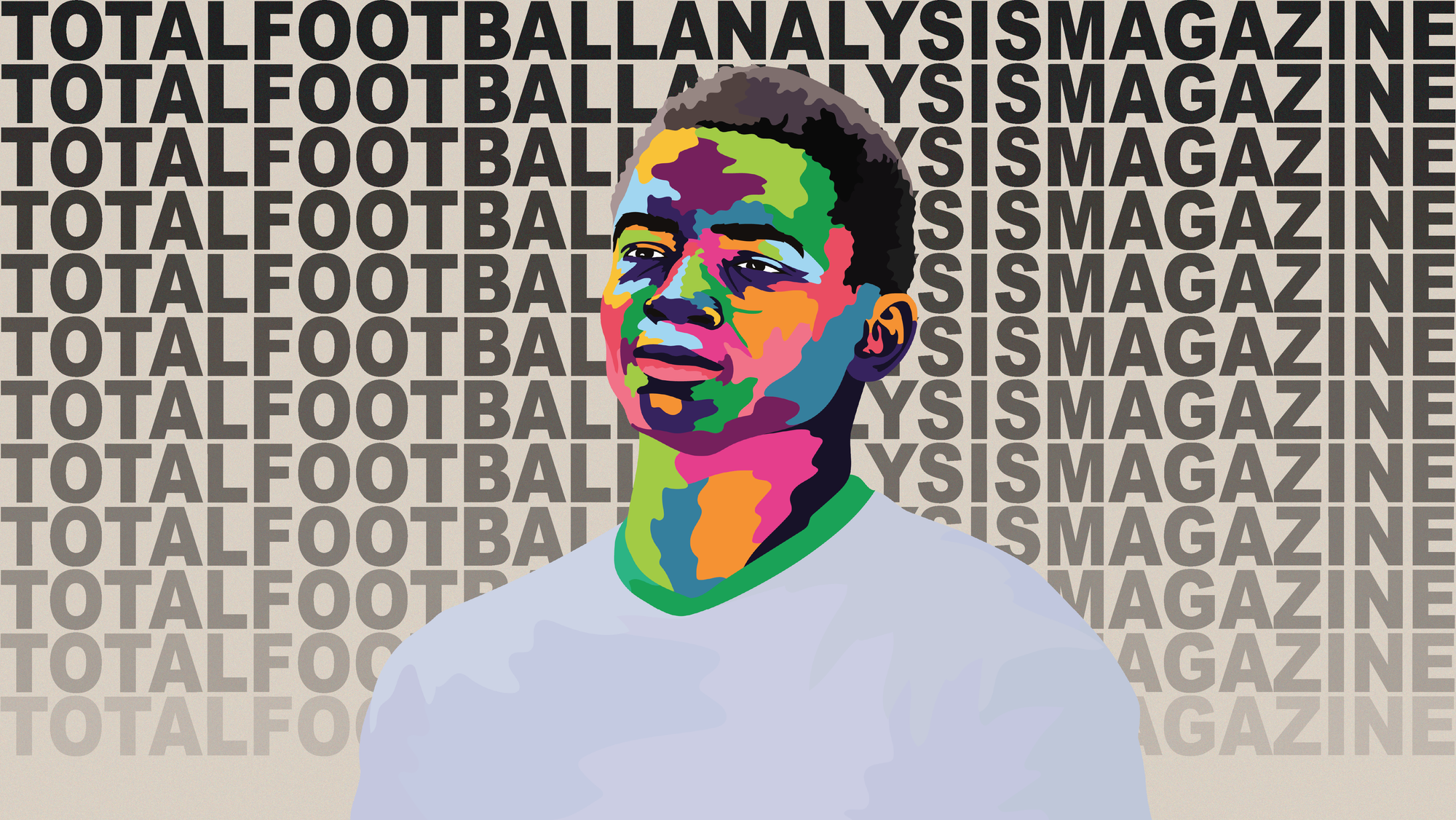
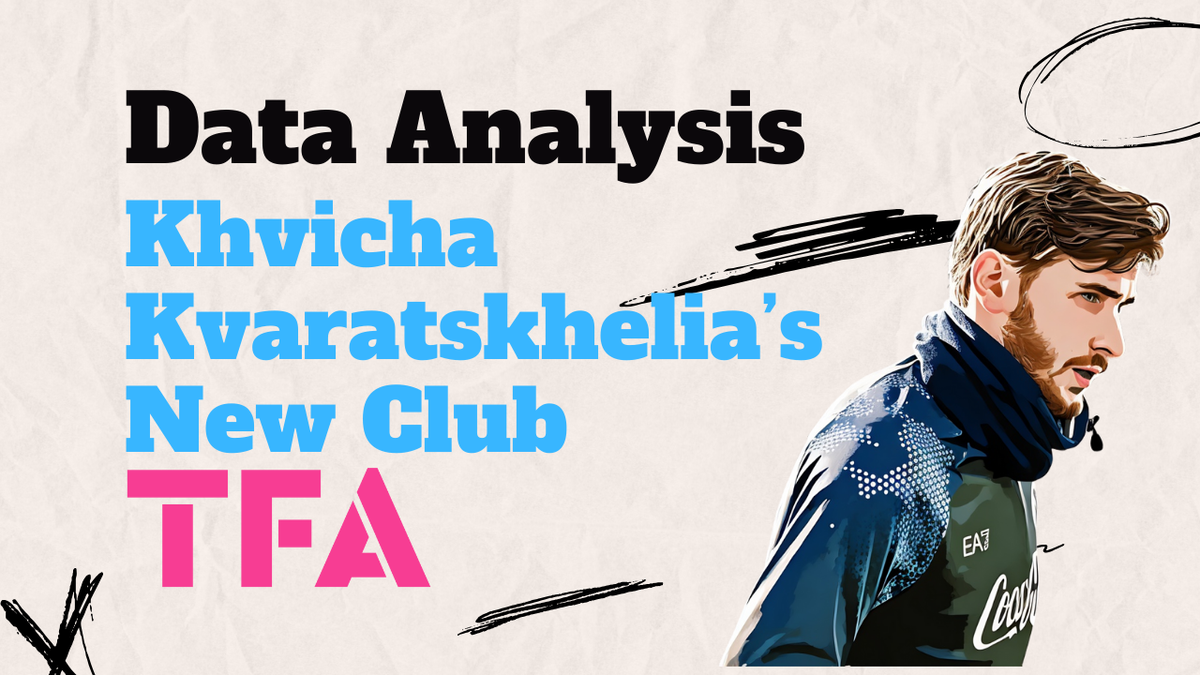

Comments